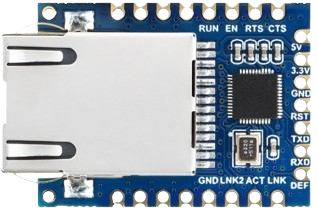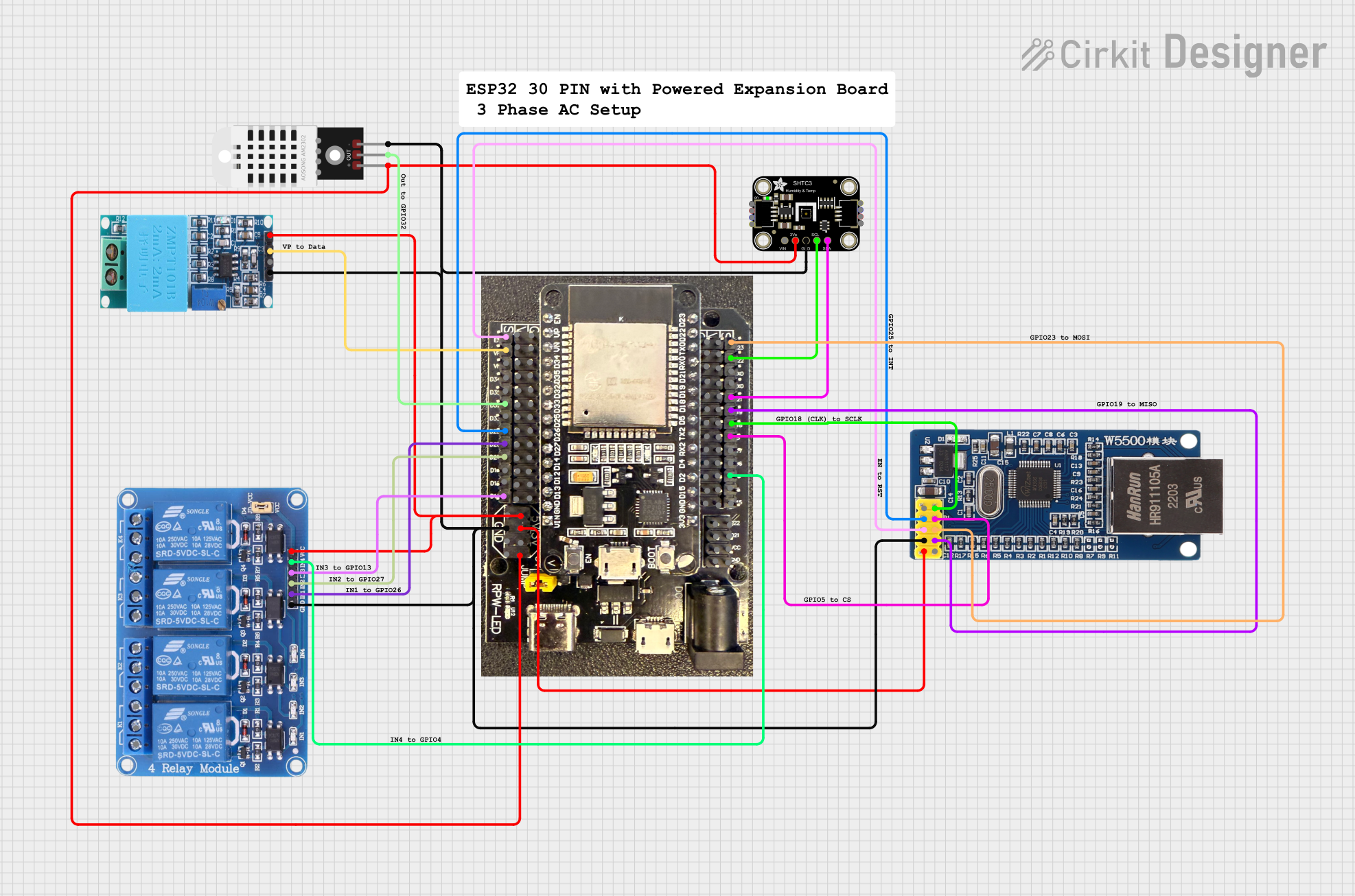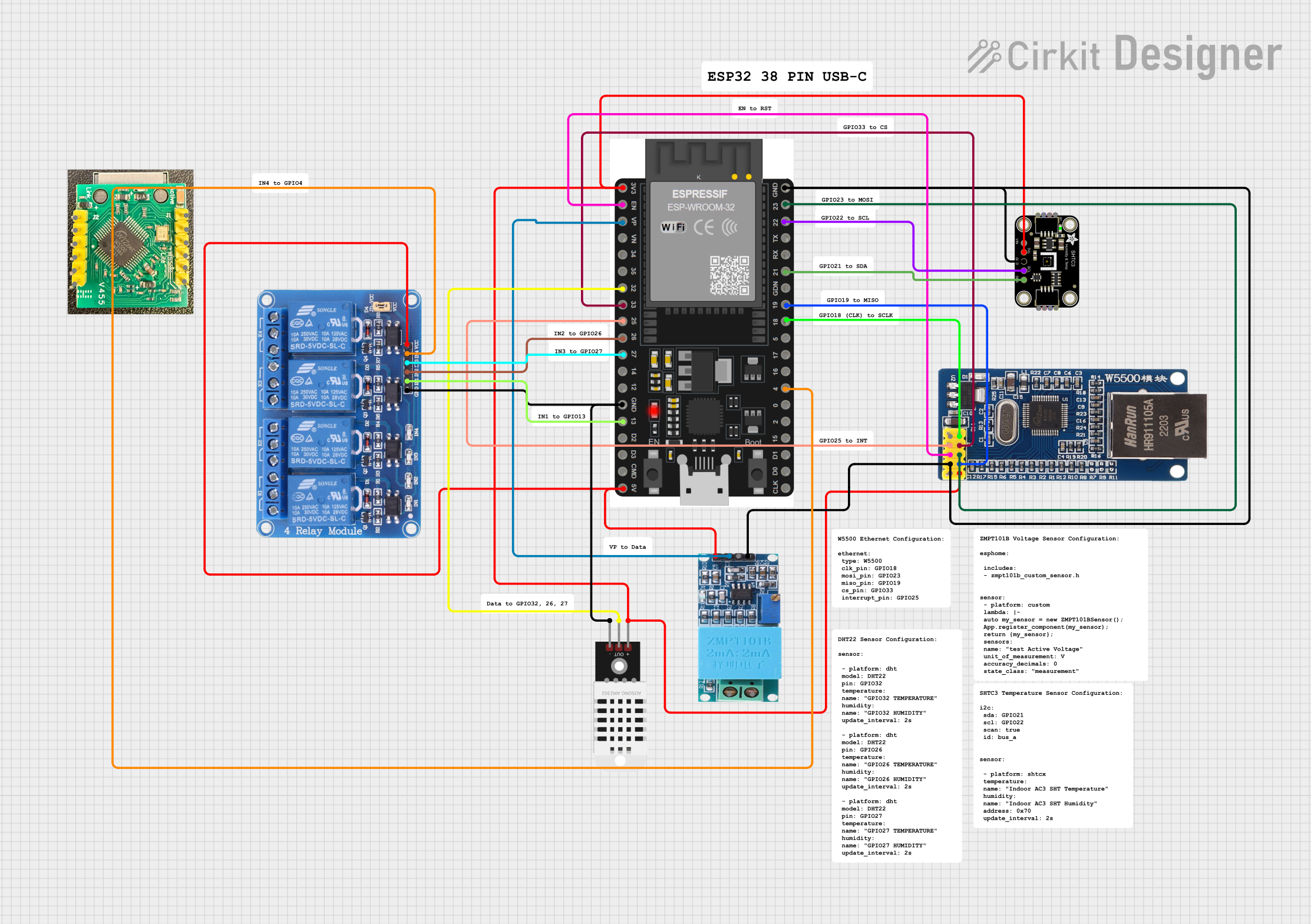
How to Use Waveshare TTL-ETH: Examples, Pinouts, and Specs

 Design with Waveshare TTL-ETH in Cirkit Designer
Design with Waveshare TTL-ETH in Cirkit DesignerIntroduction
The Waveshare TTL-ETH (Manufacturer Part ID: 24276) is a TTL to Ethernet module designed to enable serial communication over an Ethernet network. This module is ideal for applications requiring reliable and fast data transmission between microcontrollers and Ethernet-based systems. It simplifies the process of connecting embedded devices to the internet, making it a versatile choice for IoT projects, industrial automation, and remote monitoring systems.
Explore Projects Built with Waveshare TTL-ETH

 Open Project in Cirkit Designer
Open Project in Cirkit Designer
 Open Project in Cirkit Designer
Open Project in Cirkit Designer
 Open Project in Cirkit Designer
Open Project in Cirkit Designer
 Open Project in Cirkit Designer
Open Project in Cirkit DesignerExplore Projects Built with Waveshare TTL-ETH

 Open Project in Cirkit Designer
Open Project in Cirkit Designer
 Open Project in Cirkit Designer
Open Project in Cirkit Designer
 Open Project in Cirkit Designer
Open Project in Cirkit Designer
 Open Project in Cirkit Designer
Open Project in Cirkit DesignerCommon Applications and Use Cases
- Internet of Things (IoT) devices
- Remote data logging and monitoring
- Industrial automation and control systems
- Home automation projects
- Serial-to-Ethernet communication for microcontrollers
Technical Specifications
The following table outlines the key technical details of the Waveshare TTL-ETH module:
| Parameter | Value |
|---|---|
| Supply Voltage | 3.3V to 5V |
| Communication Protocol | UART (TTL level) |
| Baud Rate | 1200 bps to 115200 bps |
| Ethernet Standard | 10/100 Mbps Ethernet |
| Operating Temperature | -40°C to 85°C |
| Dimensions | 48mm × 28mm |
| Weight | 10g |
Pin Configuration and Descriptions
The Waveshare TTL-ETH module has a 7-pin interface. The pin configuration is as follows:
| Pin | Name | Description |
|---|---|---|
| 1 | VCC | Power input (3.3V to 5V) |
| 2 | GND | Ground |
| 3 | TXD | Transmit data (UART output, TTL level) |
| 4 | RXD | Receive data (UART input, TTL level) |
| 5 | CFG | Configuration pin (used to enter configuration mode when pulled low) |
| 6 | RST | Reset pin (active low, used to reset the module) |
| 7 | LINK | Ethernet link status indicator (active high when Ethernet connection is active) |
Usage Instructions
How to Use the Component in a Circuit
- Power Supply: Connect the
VCCpin to a 3.3V or 5V power source and theGNDpin to ground. - UART Communication: Connect the
TXDpin of the module to the RX pin of your microcontroller and theRXDpin to the TX pin of your microcontroller. - Ethernet Connection: Plug an Ethernet cable into the RJ45 port of the module to establish a network connection.
- Configuration Mode: To configure the module, pull the
CFGpin low during power-up. Use the provided configuration software or send AT commands via UART to set parameters such as IP address, baud rate, and communication mode. - Reset: Use the
RSTpin to reset the module if needed.
Important Considerations and Best Practices
- Ensure the power supply voltage is within the specified range (3.3V to 5V) to avoid damaging the module.
- Use a level shifter if your microcontroller operates at 1.8V or 2.5V logic levels, as the module operates at TTL levels (3.3V or 5V).
- Keep the Ethernet cable length within the recommended range for reliable communication (typically less than 100 meters for CAT5e or CAT6 cables).
- Avoid placing the module near high-frequency noise sources to maintain signal integrity.
Example: Connecting to an Arduino UNO
Below is an example of how to use the Waveshare TTL-ETH module with an Arduino UNO to send data over Ethernet.
Circuit Connections
- Connect
VCCto the 5V pin of the Arduino. - Connect
GNDto the GND pin of the Arduino. - Connect
TXDto the Arduino's RX (pin 0). - Connect
RXDto the Arduino's TX (pin 1). - Connect an Ethernet cable to the module's RJ45 port.
Arduino Code
#include <SoftwareSerial.h>
// Define RX and TX pins for software serial communication
SoftwareSerial ethSerial(10, 11); // RX = pin 10, TX = pin 11
void setup() {
// Initialize serial communication with the module
Serial.begin(9600); // For debugging via Serial Monitor
ethSerial.begin(9600); // Communication with TTL-ETH module
Serial.println("Waveshare TTL-ETH Module Test");
ethSerial.println("Hello, Ethernet!"); // Send data to the module
}
void loop() {
// Check if data is available from the module
if (ethSerial.available()) {
String data = ethSerial.readString();
Serial.print("Received from Ethernet: ");
Serial.println(data); // Print received data to Serial Monitor
}
// Check if data is available from Serial Monitor
if (Serial.available()) {
String data = Serial.readString();
ethSerial.print(data); // Send data to the Ethernet module
}
}
Troubleshooting and FAQs
Common Issues and Solutions
No Ethernet Connection Detected:
- Ensure the Ethernet cable is securely connected to the module and the network.
- Verify that the
LINKpin is high, indicating an active Ethernet connection. - Check the network configuration (IP address, subnet mask, etc.) using the configuration software.
No Data Transmission:
- Verify the UART connections (TXD and RXD) between the module and the microcontroller.
- Ensure the baud rate of the module matches the baud rate set in your microcontroller code.
- Check for any loose or incorrect wiring.
Module Not Entering Configuration Mode:
- Ensure the
CFGpin is pulled low during power-up. - Verify the power supply voltage is stable and within the specified range.
- Ensure the
Module Not Responding to Commands:
- Reset the module using the
RSTpin and try again. - Confirm that the module is powered on and the UART connections are correct.
- Reset the module using the
FAQs
Q: Can the module operate at 1.8V logic levels?
A: No, the module operates at TTL levels (3.3V or 5V). Use a level shifter for compatibility with 1.8V systems.
Q: What is the maximum baud rate supported by the module?
A: The module supports baud rates up to 115200 bps.
Q: Can I use the module with a Raspberry Pi?
A: Yes, the module can be used with a Raspberry Pi. Connect the UART pins to the Raspberry Pi's GPIO pins and configure the serial port accordingly.
Q: How do I update the firmware of the module?
A: Refer to the manufacturer's documentation for firmware update instructions, as this process may require specific tools or software.
Q: Is the module compatible with DHCP?
A: Yes, the module supports both static IP and DHCP configurations. Use the configuration software or AT commands to enable DHCP.